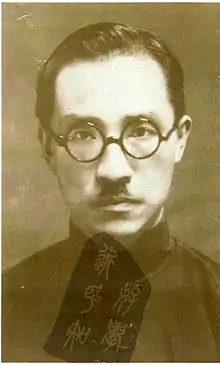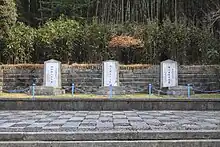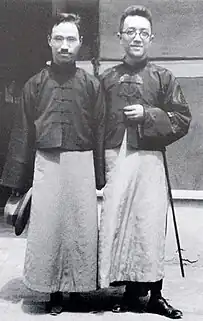Hu Xiansu | |
|---|---|
| 胡先骕 | |
 | |
| Born | 24 May 1894 |
| Died | 16 July 1968 (aged 74) |
| Resting place | Mount Lu, Jiangxi |
| Nationality | Chinese |
| Citizenship | China |
| Alma mater | |
| Known for |
|
| Children | 6 |
| Scientific career | |
| Fields | |
| Doctoral advisor | John George Jack |
| Notable students | Wang Wencai |
| Author abbrev. (botany) | Hu |
Hu Xiansu or Hu Hsien-Hsu (simplified Chinese: 胡先骕; traditional Chinese: 胡先驌; pinyin: Hú Xiānsù; Wade–Giles: Hsu Hsien-Hsu, 24 May 1894 – 16 July 1968), was a Chinese botanist and an influential traditional scholar of his time. He was the founder of plant taxonomy in China and a pioneer of modern botany research and paleobotany in the country.[2]
In the 1940s, he played a key role, along with Wan Chun Cheng, in identifying the modern existence of the long thought extinct genus Metasequoia, an achievement widely regarded as "the greatest discovery of botany in 20th century".[2][3]
He is also known for co-founding The Critical Review Journal, a major Chinese-language journal promoting traditional Chinese culture and values during the New Culture Movement.[4]
Education and career
Born on May 24th 1894 in Xinjian (now Xinjian district, Nanchang), Jiangxi, Hu studied preparatory course at Imperial University of Peking in 1909. In spring 1912, the 1911 Revolution overthrown the Qing Empire thus discontinued the operation of the university. Hu went to the United States in December 1912 and enrolled in University of California (now University of California, Berkeley). During his years in Berkeley, Hu became an active member of the newly founded Science Society of China and joined the editorial board of the Society's journal Science. At the same time, Hu read extensively of literature works in English. In May 1916, Hu graduated with honor in botany. In 1918, he became a faculty member of National Nanking Higher Normal School (later renamed National Southeastern University, National Central University and Nanking University).
In 1920 and 1921, Hu conducted large scale plant collections in Zhejiang and Jiangxi, naming the new genus (Sinojackia) in 1920, the first Chinese to do so. In 1922, Hu and Ping Chih founded the first biology department in Chinese public universities (Previously, only missionary universities in China had biology departments). In 1923, Hu and colleagues published the textbook Advanced Botany, which was the first of such textbook complied by Chinese scholars and became widely used in universities around China.
Hu went to the United States again in 1923 and received a doctoral degree from Harvard University in 1925. His doctoral dissertation, under supervision of dendrologist John George Jack, is the first comprehensive survey of plants in the whole of China.
After his wife died in Nanking in 1926, Hu resigned from Department of Biology of Southeastern University and became a full-time research fellow at Institute of Biology of China Science Society. In 1928, he moved to Beijing and co-founded the Fan Memorial Institute of Biology. Hu directed the botanical branch of the Fan Memorial and from 1932 served as the director of the Institute until 1949. Meanwhile, he taught part-time in the biology departments of Peking University and Beijing Normal University. Hu founded Lushan Botanical Garden in Jiangxi in 1934. Through Hu's influence, Lushan Botanical Garden established wide exchange networks with botanical gardens and research institutes around the world. In 1936, fearing for the likelihood of war in north China, Hu established the Yunnan Institute of Agriculture and Forest (later renamed Kunming Institute of Botany, Chinese Academy of Sciences) in southwestern China.[2][5]
In 1934, Hu named the new plant family Torricelliaceae. Becoming the first Chinese botanist to describe a new family. Over his career, Hu named and described several hundred new species of plants.[2]
Hu co-authored The Miocene Flora of Shandong Province, China between 1938 and 1940 with Ralph W. Chaney, it was the first work investigating China’s Cenozoic fossil plants, and is considered the cornerstone of current knowledge of Asian Cenozoic plants.[2]
Along with his colleagues of the Science Society of China, Hu was a key leader of the first biological research institute in the country, and played an important role in founding the Botanical Society of China, serving as its second president. Hu later established the first plantation for botanical research at Mount Lu in Jiujiang, and initiated or conducted large-scale survey of flora of China.
Between 1940 and 1944, he was the founding president of the National Chung Cheng University (renamed National Nanchang University in 1949). In the 1940s, he played a key role, along with Wan Chun Cheng, in identifying the modern existence of the genus Metasequoia, an achievement widely regarded as "the greatest discovery of botany in 20th century",[3] also co-naming the newly discovered species previously known only from fossils, in Sichuan, China.[6]
In the 1950s, Lysenko's anti-Mendelian doctrines in genetics dominated biological science and agricultural practices in China. Despite this environment, Hu was openly critical of Lysenko's doctrines, stating it as pseudoscience. For this Hu was publicly denounced, and the textbook which he wrote containing material related was banned. Later Hu was not elected as an Academician to the Chinese Academy of Sciences despite his numerous contributions, something partially attributed to his opposition to Lysenkoism.[7]
Between 1950 and 1968, he served as a researcher at the Institute of Plant Taxonomy and the Institute of Botany, Chinese Academy of Sciences.
Later life and death

In may 1968 during the midst of the Cultural Revolution, Hu was informed by his workplace that his salary "was suspended". His home was repeatedly ransacked and the books, calligraphy and paintings he had collected throughout his lifetime were confiscated by the workplace. Hu had to endure repeated struggle sessions, in which he was ordered to wear the Kuomintang flag to signify his past relation. On July 15, he was notified to go to his workplace the next day to attend extended struggle sessions, the stress that the news caused on Hu was massive. On the early morning of July 16, 1968, Hu was found dead on his bed, having suffered a heart attack.[8][9]Hu's funeral was commenced in the Babaoshan Revolutionary Cemetery on May 15, 1979. He was buried at Lushan Botanical Garden at Mount Lu on May 15, 1984.
See also
Notes
- ↑ Jiang, Lijiang (April 2016). "Retouching the Past with Living Things: Indigenous Species, Tradition, and Biological Research in Republican China, 1918–1937". Historical Studies in the Natural Sciences, University of California Press. 46 (2): 154–206 – via ResearchGate.
- 1 2 3 4 5 Hu, Xiaojiang; Ma, Jinshuang (2022-04-01). "The Founder of Plant Taxonomy in China: HU Hsen-Hsu". Protein & Cell. 13 (4): 231–233. doi:10.1007/s13238-021-00877-0. ISSN 1674-8018. PMC 8934367. PMID 34564807.
- 1 2 LePage, Ben A.; Williams, Christopher J.; Yang, Hong (2005-03-30). The Geobiology and Ecology of Metasequoia. Springer Science & Business Media. ISBN 978-1-4020-2631-7.
- ↑ Fung, Edmund S. K. (2009). "Nationalism and Modernity: The Politics of Cultural Conservatism in Republican China". Modern Asian Studies. 43 (3): 777–813. ISSN 0026-749X.
- ↑ "中国近代植物学研究先驱者——胡先骕----中国植物学会". www.botany.org.cn. Archived from the original on 2023-11-16. Retrieved 2023-11-16.
- ↑ Bell (2016), pp. 263, 269, 279.
- ↑ "沈善炯回忆录:历尽磨难回国,被迫"改行",却仍做出重大贡献-深度-知识分子". zhishifenzi.com. Archived from the original on 2023-02-09. Retrieved 2023-02-09.
- ↑ "新书介绍:《胡先骕先生年谱长篇》 - 中国知网". 2022-06-06. Archived from the original on 2022-06-06. Retrieved 2023-01-20.
- ↑ "得书记︱我的胡先骕手迹收藏_上海书评_澎湃新闻-The Paper". www.thepaper.cn. Archived from the original on 2023-01-20. Retrieved 2023-01-20.
- ↑ International Plant Names Index. Hu.
References and further reading
- Bell, Andrew W. (2016). "A Tree Grows in China". Journal of American-East Asian Relations. 23 (3): 257–281. doi:10.1163/18765610-02303006.
